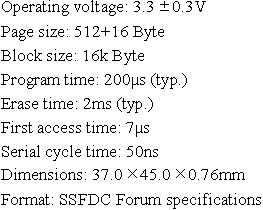| Toshiba Develops Double Density SmartMedia(TM) 10 December, 1997
SmartMediaTM to market
Tokyo--Toshiba Corporation today announced a breakthrough in control technology that doubles the capacity of its popular SmartMediaTM removable storage media cards while retaining their small size and simplicity of use. The first commercial SmartMediaTM cards using the new technology have a capacity of 16 megabytes, twice that of the largest capacity cards now available, and will debut in 1998, with sample shipment scheduled for the first quarter of the year. SmartMediaTM cards are a highly compact, light, cost-effective data storage cards for personal digital media. They are little over the size of a postage stamp, and their use of a NAND flash memory chip supports high speed rewriting of individual memory sectors. These pluses have already won SmartMediaTM a central position in such emerging markets as data storage for digital still cameras. The growing popularity of the card has been accompanied by a demand for larger capacities. Toshiba's breakthrough doubles card memory capacity while retaining its original size. A control circuit within the NAND chip treats two separate chips as a single chip, while the company's advanced mounting technology allows the two chips to be assembled on a single printed circuit board and pasted in the base card. The result is doubled capacity in a base card with exactly the same dimensions and contact area. Toshiba currently produces two, four and eight-megabyte SmartMediaTM cards, each incorporating a single NAND chip. In the new card scheduled for launch in early 1998, the company had used its new control technology to combine two 64-megabit NAND chips in a 16-megabyte (128 megabit) SmartMediaTM card that fully meets the specifications published by the SSFDC Forum (Solid-State Floppy-Disk Card Forum) this November. The increased capacity SmartMediaTM cards will promote the development of new features for personal digital equipment, including recording of sound, images and other data. Early applications are expected to include storage of e-mail downloaded to personal communications terminals and in solid-state personal voice recorders. The higher capacity will also support higher resolution images in future generations of digital camera. Toshiba developed the original NAND flash memory technology used in SmartMediaTM and has promoted its use through intensive product development. The company is committed to further product development and commercialization, and plans to push memory capacity to 1gigabit by 2001, while observing the SSFDC forum standard. Development of the double density card will assist the company in achieving these targets.
 Specifications of 16 megabyte SmartMediaTM
Specifications of 16 megabyte SmartMediaTM

|
| Information in the press releases, including product prices and specifications, content of services and contact information, is current on the date of the press announcement,but is subject to change without prior notice. |



